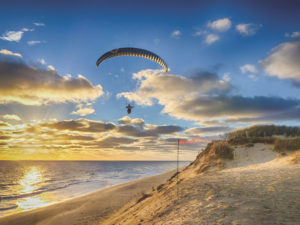WELLFLEET — The Outer Cape’s beaches are desolate this time of year. The only sign of human life may be the brave souls who trek the beaches on days that aren’t too frigid.
But on a nice day, when the northeast winds are blowing just right, visitors may see the hang gliders and paragliders who travel from around New England to fly along the Outer Cape coastline. It is a sight to behold for both those on the beach and those in the air.
“Cape Cod is such a beautiful landscape,” says Jon Atwood. “There’s nothing else like it in the country.”

Atwood, who lives in Sudbury, is one of 140 members of the New England Paragliding and Hang Gliding Club. They hail from across New England and even New York. Pilots can be found across the world — paragliding and hang gliding are popular in Europe and South Africa, too.
Pilots, or foot-launch aviators as they are also known, who are in the local club enjoy gliding over mountains and flat lands of New England all year. But in winter, when the weather is right, many travel to Wellfleet.
The gliding season on the Outer Cape runs from Oct. 2 to April 15. The sport is not allowed at other times due to piping plover nesting.
“We work a lot on safety and try to be sure pilots aren’t walking on the dunes,” Atwood says.
There may only be one or two days a month where the weather cooperates for a launch. Wind, tides, and precipitation are key factors. Pilots launch from White Crest Beach in Wellfleet when the northeast winds are blowing at the right velocity.
Donna Parssinen, a paraglider from Westerly, R.I., first flew Wellfleet in 2016. She said ideal winds are typically around 10 miles per hour. Winds exceeding 18 miles per hour are too strong. The ideal conditions usually occur before a storm.
Thermic conditions are created when the sun heats the air and creates air currents that can sometimes allow gliders to circle up to the base of the clouds. Most gliders do this only when flying over mountains or a large flatland and not above the coastline.
Parssinen has flown in Germany, Austria, Brazil, and Colombia. She says the dynamic sea breeze off the Outer Cape makes navigation challenging, but she has high praise for Wellfleet.
“You can see across the Cape,” she says. “Wellfleet’s the most beautiful coastal site that I’ve flown on.”
Of course, flying in the winter requires heavy layers. She usually wears wool undergarments, thick gloves, and a skimobile-type snowsuit.
Paragliding pilots fly seated, while a hang glider has a frame and pointed nose, so pilots fly Superman-style.
“It’s cool — more of a bird-like posture,” Atwood says.
Hang gliding has been around since about 1970 while paragliding was introduced around 1990.
Pete Williams, another member of the club, says that when paragliding was first introduced hang gliders were territorial and afraid these new pilots would take over their airspace.
But the two groups have come to respect each other and a lot of hang gliding pilots are actually turning to paragliding because the equipment is easier to carry and transport.
Gliders on the Outer Cape typically try to fly between Highland Light in Truro and Nauset Light in Eastham. On a good day they can fly along the coastline for hours. Atwood says he once flew back and forth between the lighthouses for nearly five hours.
Paragliders typically fly at 20 to 30 miles per hour, while hang gliders fly about 50 miles per hour.
This hobby requires dedication, but most gliders have day jobs and families. Not only must the weather be right, but their life and work schedules must align for them to get to the Cape.
Early mornings are usually the best. “Sunrise flights are just magic,” says Atwood. “Sometimes you launch off as soon as the light comes up. When it’s good, people will drive long distances and stay in a hotel to try and catch the magic flight.”
The gliding community brings business to motels, restaurants, and shops during the slowest time of year on the Cape. Williams says he stayed at the Town Crier in Eastham last weekend.
Paragliding is about as “safe” as driving, say its fans, and statistics support this view.
“You’re risking your life for this wonderful experience,” says Williams.
Atwood says he enjoys mentoring younger pilots. In Wellfleet there’s always a range of ages that show up.
“It’s a wicked variety of ages,” he says. “I always have someone I’ve been flying with for 20 years and there’s always someone who is new.”
There’s 20 miles of coastline that pilots can fly over on the Outer Cape — some choose to do crazy maneuvers in the sky while others just focus on flying. Either way, every pilot feels appreciation.
“Wellfleet is such a special place for us,” says Williams, “and we’re limited in the amount of time we can fly there.”



